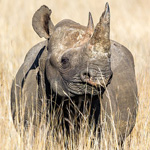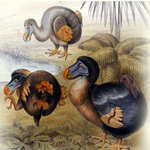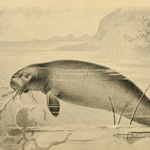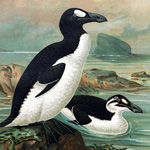Our History
We work to END the trade in ivory and rhino horn and strive for a livable earth for all living things.
#MarchAgainstExtinction
Western Black Rhino
Declared extinct in 2011.
The disappearance of this rarest species of black rhino was driven by the demand for its horn; rhino horn is used in Traditional Chinese Medicine (#TCM) and as an aphrodisiac. The demand for rhino horn continues in China, Vietnam, and Asia despite no scientific evidence substantiating the claim that rhino horn is “medicine”. Rhino horn is made of the same substance as human hair and nails, Keratin. The Western Black Rhino had very poor eyesight, however, was gifted with an excellent sense of smell and hearing; despite its considerable bulk, it could clock speeds as high as 55 km/h. Tragically, none of these unique evolutionary traits saved the species from being decimated by Traditional Chinese Medicine.
Image Credits – Zambog, Wiki Media
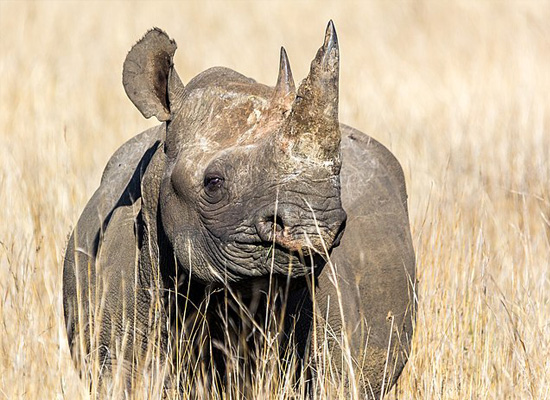
Woolly Mammoth
Extinct around ~1700BC.
The last population of wooly mammoths are thought to have disappeared from the planet around ~1700BC; the enormous mammal migrated out of Africa ~3.5 million years ago, extending its range across North America and Eurasia. Closely related to elephants, wooly mammoths had curved tusks that were 5 or more meters long! The animal disappeared from the planet from a combination of overhunting by humans and a sudden and extreme cold snap caused by climate change.
Image Credits – FunkMonk, Wiki Media
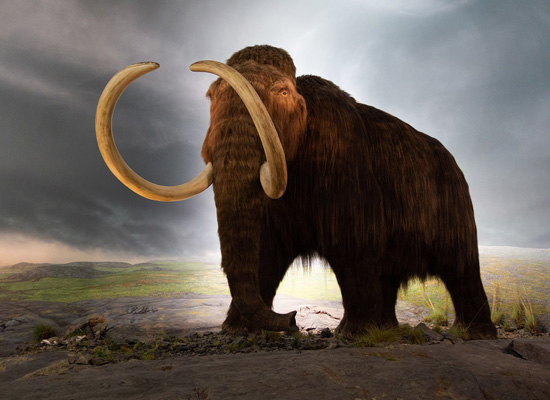
Sabre-toothed Cat
Extinct around ~10,000 years ago.
As with the extinction of the woolly mammoth, human interference and climate change are believed to have caused the demise of the sabre-toothed cat; the decline and disappearance of the mastodon, the mammoth and other large herbivores are consequences of the same causal factors, those which in turn influenced the extinction of the sabre-toothed cat. Sabre-toothed cats are often referred to as sabre-toothed tigers or sabre-toothed lions; however, the animal was of a different sub family from tigers; ergo the term ‘tiger’ is a misrepresentation. Profound pathos accompanies the knowledge that these bear-like creatures, who were excellent hunters, whose jaws opened at 120 degrees to expose canines that were ~50-cm long, survived on the planet for some ~56 million years and then succumbed to extinction, as did so many other creatures, with the advent of humans.
Image Credits – Smilodon Fatalis, Wiki Media
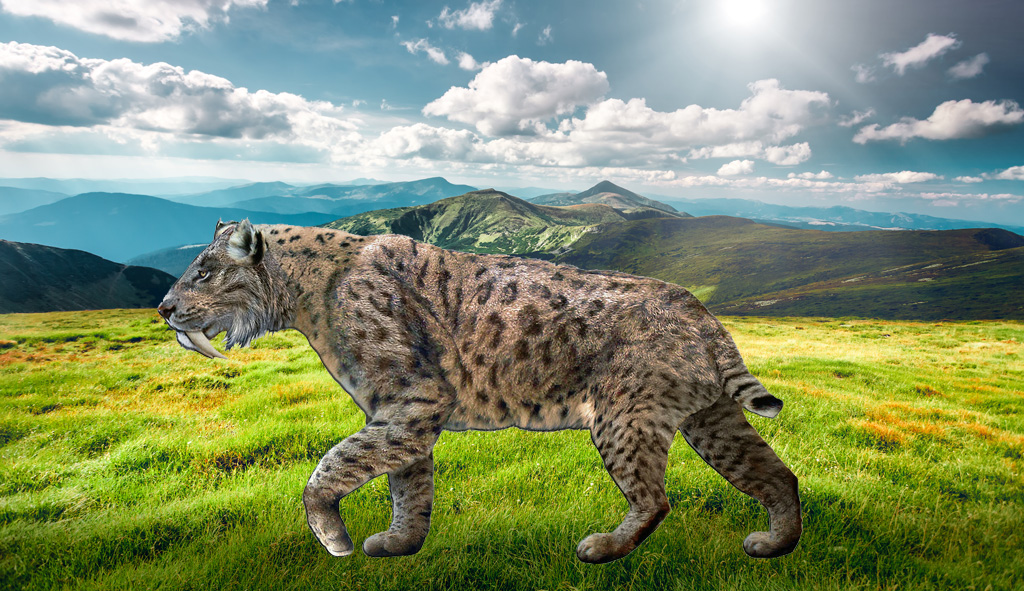
Dodo
Extinct around ~1662.
Native to Mauritius, the Dodo was a flightless bird, hunted to extinction by Dutch sailors, invasive species, and domesticated animals. The evolution of the Dodo to be flightless may have been the result of the availability of an abundance of ground-based food sources coupled with the absence of predators. An adult Dodo was about ~1 meter tall and may have weighed as much as ~18 kg.
Image Credits – Richard Owen, Wiki Media
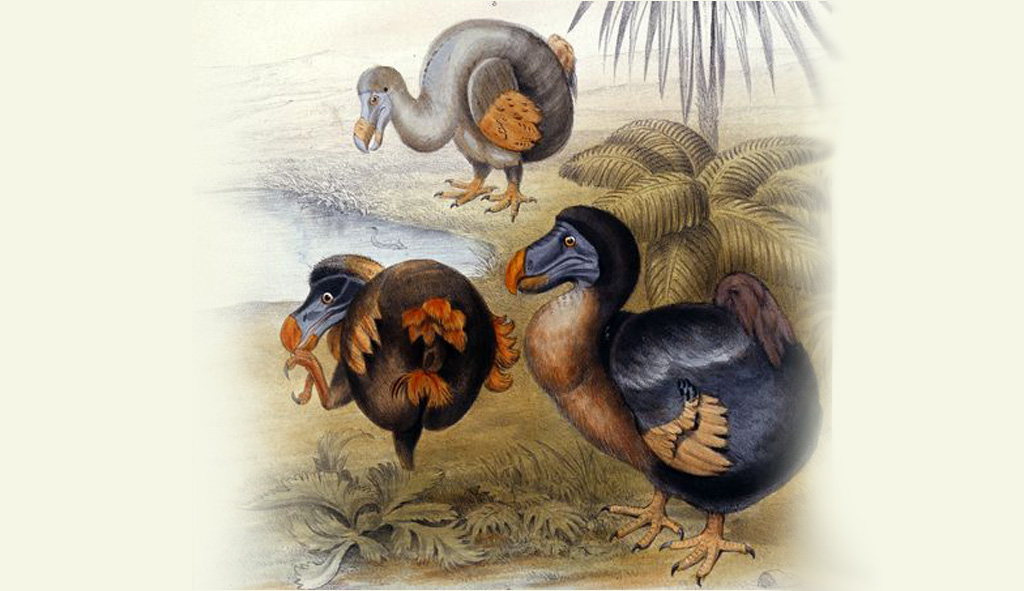
Tasmanian Tiger
Extinction in the wild between ~1910-1920.
Extinct in captivity around ~1936.
A large carnivorous marsupial unrelated to tigers, the Tasmanian tiger was native to Australia, Tasmania, and New Guinea. Harboring the appearance of a mid to large sized dog, the Tasmanian tiger was striped; an adult weighed ~30kg and measured ~2 meters, nose to tail. The Tasmanian tiger was hunted to extinction; additionally, habitat loss to humans, diseases, domesticated animals, and bounty hunting may have accelerated its demise.
Image Credits – Gould, Wiki Media
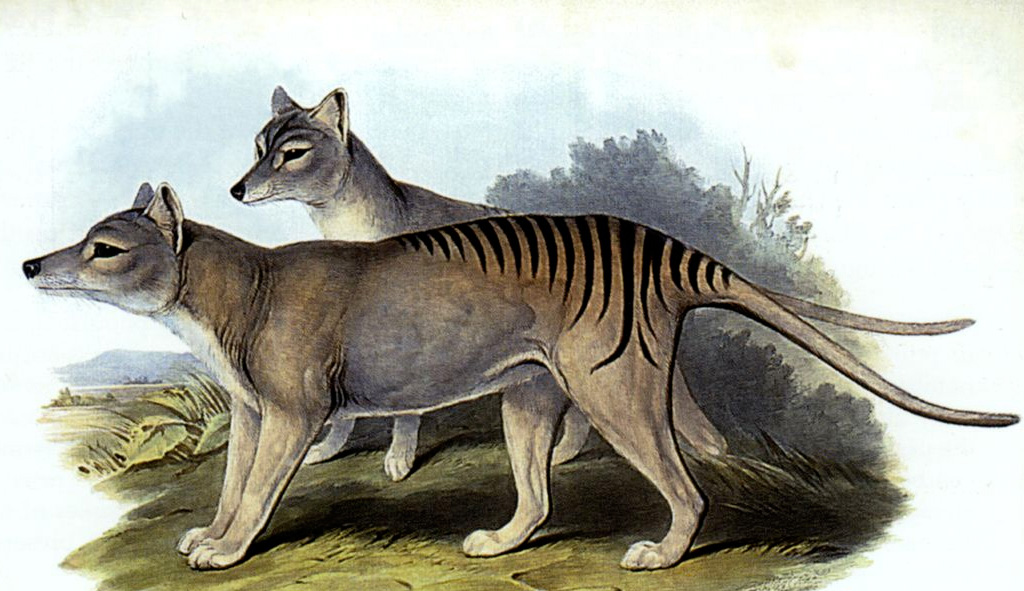
Stellers Sea Cow
Declared extinct in 1768.
The Stellers Sea Cow was hunted to extinction by Europeans a mere 27 years after its discovery by the naturalist George Steller in 1741. The Stellers Sea Cow was a native of the Near Islands or Sasignan Islands in the Aleutian Island chain in southwestern Alaska. The herbivorous creature was tame and spent most of its time eating kelp. It is believed that the animal was unable to fully submerge its enormous body; this fact and its tameness may have rendered the creature extremely venerable to humans.
Image Credits – KKPCW, Wiki Media
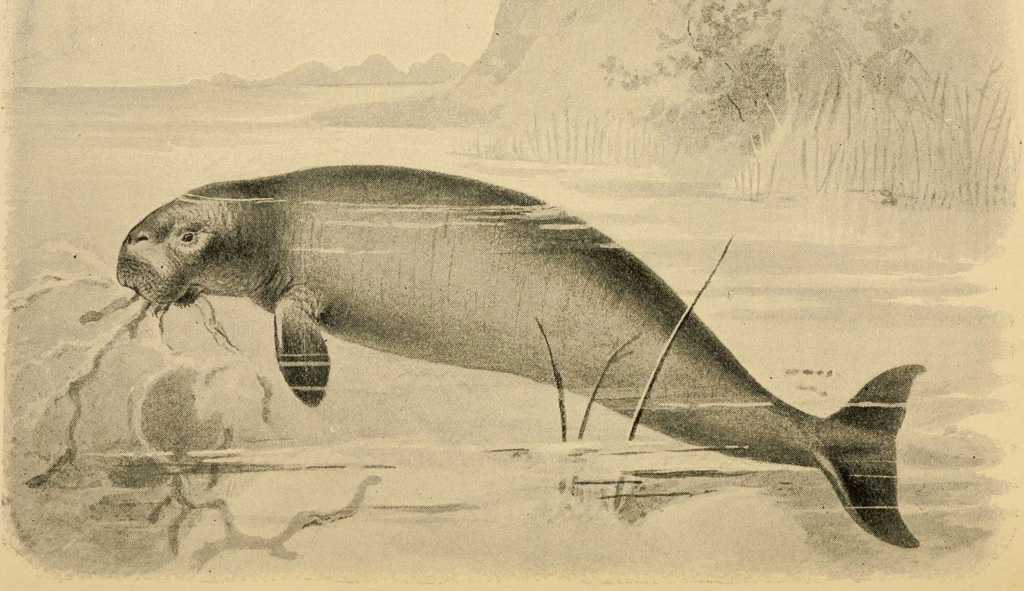
Great Auk
Extinct around ~1844.
A powerful swimmer and a great underwater hunter, the last colony of great auks lived on the island of Eldey; by 1835 they had all been killed. In 1844, the last of the great auks was caught by three men on St. Kilda in Scotland; when a great storm surged, the men convinced themselves that the bird was a witch who caused the storm; the three men then killed the last of the great auks. An adult Great Auk was about ~85 cm feet tall and weighed about ~5kg.
Image Credit – John Gerrard Keulemans, Wiki Media
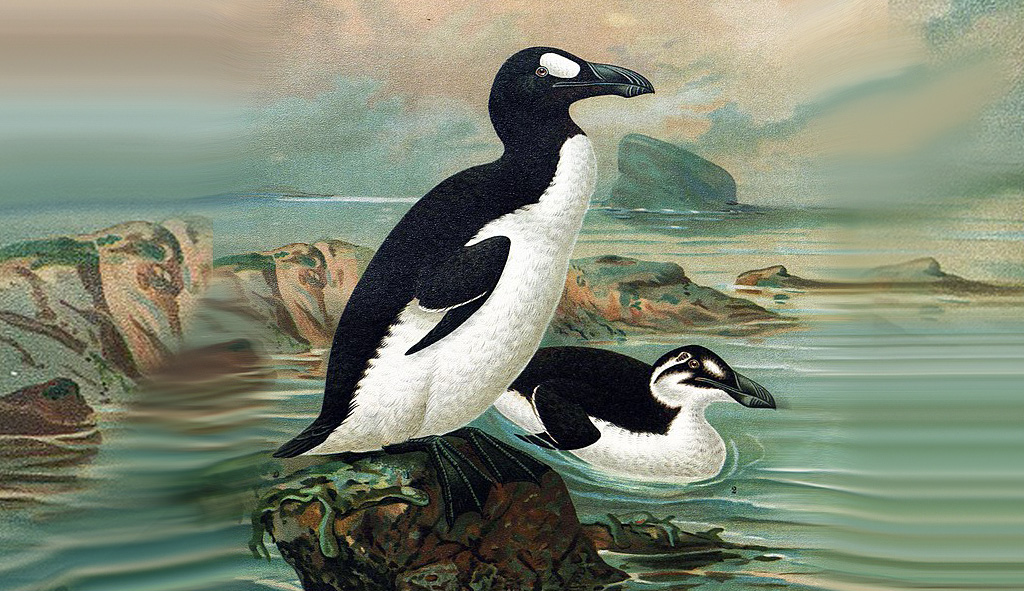
GMFER Timeline
They began with KUAPO (Kenyans United Against Poaching); KUAPO was founded in 2013 in the wake of one of worst elephant massacres in Kenya when a family of eleven elephants was slaughtered in Tsavo following a continent-wide surge in poaching in preceding years. Within days of the massacre, KUAPO planned a protest march in Nairobi calling Kenya’s government to declare poaching a national disaster and demanding the judiciary set up a special court for cases related to wildlife crime. The march in Nairobi was attended by 100s, driving nation-wide marches in seven cities across Kenya. KUAPO also wrote to all concerned embassies petitioning a ‘hard line stance’ against wildlife crime. These key activities spurred a national movement on behalf of Kenya’s iconic animals and her disenfranchised humans.
Here is what is important to underline; there was difference this time around. A nascent and energetic movement founded and fueled by ordinary citizens, a departure from the standard bevy of “conservation heroes” was at the front lines of wildlife advocacy. Concerned and caring citizens wanted governments to be accountable; a grass-roots movement of a different kind was alive and growing.
The movement KUAPO galvanized in collaboration with other conservation organizations, including the DSWT (David Sheldrick Wildlife Trust); helped spur the passage of Kenya’s Wildlife Conservation and Management act of 2013, ushering-in stronger laws addressing rampant poaching.
Months later, also in 2013, KUAPO was contacted by the DSWT to help coordinate a march to the Chinese Embassy in Kenya with the objective of targeting China’s culpability in the ivory trade. DSWT then issued an appeal across the globe for international marches in key cities; several major cities around the world heeded the call. In the end however, DSWT decided against ‘provoking’ Chinese interests by requesting that marches and events did not specifically single-out Chinese institutions.
DSWT’s international marches in 2013 were beautiful, passionate and successful; they amplified global awareness about the tragic fate faced by elephants.
KUAPO’s founders are Salisha Chandra, Julie Dawson, Raabia Hawa, John Mbaria, and Jamey Ponte.

Advocates and activists in the city of San Francisco joined DSWT’s international iWorry marches in 2013. As plans proceeded to unfold for the San Francisco march, it became apparent that marching through the city’s Chinatown was imperative. Multiple commercial outlets in Chinatown were trading in all forms of ivory, making the functional distinction between the legal and illegal trade indistinguishable.
DSWT’s criteria for participation in the 2013 events was to refrain from targeting any specific “Chinese Interests”; this requirement posed a dilemma for the diverse coalition of activists organizing the march in San Francisco. After much deliberation and heartache, the San Francisco group decided to break ranks and march independent of DSWT.
“We wanted to take a meaningful stand for elephants, it was the ivory market, both legal and illegal that was driving elephants to extinction – so where better to march than in front of an ivory store?” — Rosemary Alles: 2013: Co-founder, March for Elephants, San Francisco.
The decision to march independently spurred the birth of March for Elephants, San Francisco (MFE).
On World Animal Day, October 4 2013, thousands marched through the streets of Chinatown in San Francisco demanding an end to the ivory trade. We marched for the great bull Igor, for beloved Qumquat and her slain family and for many hundreds of thousands of others –all killed for trinkets. The dead were remembered, honored and grieved at ceremonial milestones along Chinatown’s main artery, Grant Avenue. The march drew civil, fierce, creative and peaceful attention to multiple commercial outlets trading elephant ivory.
Also in 2013 and immediately preceding the march in Chinatown, MFE commissioned and sponsored a crowd-funded Bill Board in Times Square, New York. The exquisitely crafted presentation advocated against the purchase of all elephant ivory. The commissioned work was the creation of wildlife conservation artist Asher Jay.
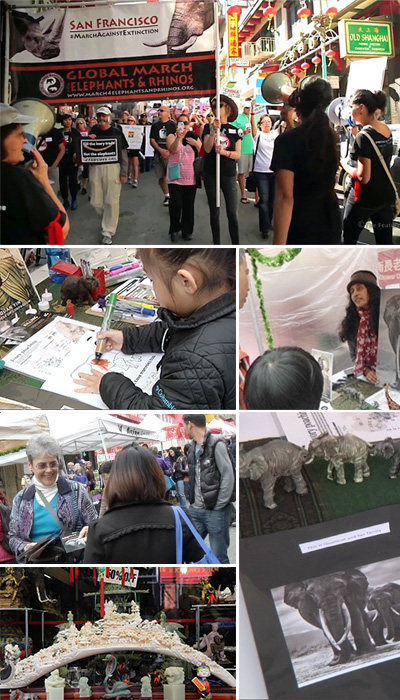
Propelled by independent grassroots energy, March for Elephants San Francisco expanded the scope of its advocacy and outreach. A broader-based nonprofit was formed; founding members were from the United States and the United Kingdom. The core team had participants from multiple nations, including several from Africa. The goal was to organize events, marches and action across the world, to grow international awareness about the poaching crisis, to pressure governments to change laws and policies in favor of wildlife and to generate a powerful wave of strategic –global- advocacy.
In the tradition that celebrated its roots in the original San Francisco group, the Global March for Elephants and Rhinos (GMFER) was born.
GMFER works with indigenous communities to influence governments and world leaders to end the trade in ivory and rhino horn; we strive for a livable earth for all living things by amplifying indigenous voices and progressive intersectional change on a global scale.
Collaborating with leads from multiple nations, GMFER organized and sponsored more than 130 marches and events around the world in 2014 and 2015. The historical and unprecedented wave of advocacy pressured and influenced international wildlife policy makers. The U.S. Department of State described the global events in this way:
“People in more than 130 cities around the world, including Hong Kong, Nairobi and Washington, participated in October’s Global March for Elephants and Rhinos. According to experts, these marches keep political pressure on leaders to protect the world’s largest land animal.” Share America
Also, in 2015, GMFER collaborated with the Humane Society of the United States (HSUS) and others to spur the passage of AB 96, a legislative bill that imposed a total ban on ivory sales within California. Many of GMFER’s members testified at the state’s capital in Sacramento in support of the measure. Additionally, GMFER gathered thousands of signatures from across the state in favor of the bill, sorted them by crucial senate and congressional districts and delivered them to lawmakers in Sacramento via HSUS; cementing the case for a total ban. In October 2015, Governor Brown signed AB 96 into law: a major victory for wildlife.
In December 2015, members of GMFER travelled to Hawaii to lobby the Aloha state’s legislators in support of a wildlife trafficking ban. Over the span of several weeks and in partnership with the HSUS, GMFER visited the offices of numerous Hawaii lawmakers making the case for banning the trade in ivory, rhino horn and other endangered wildlife. Also, over the months of December 2015 and January 2016, members of GMFER’s core team worked to research Hawaii’s online ivory market on behalf of a report published subsequently by a coalition of organizations. These concerted efforts spurred and supported the passage of Hawaii’s wildlife trafficking ban in 2017, one of the nation’s broadest trafficking bans at the time.
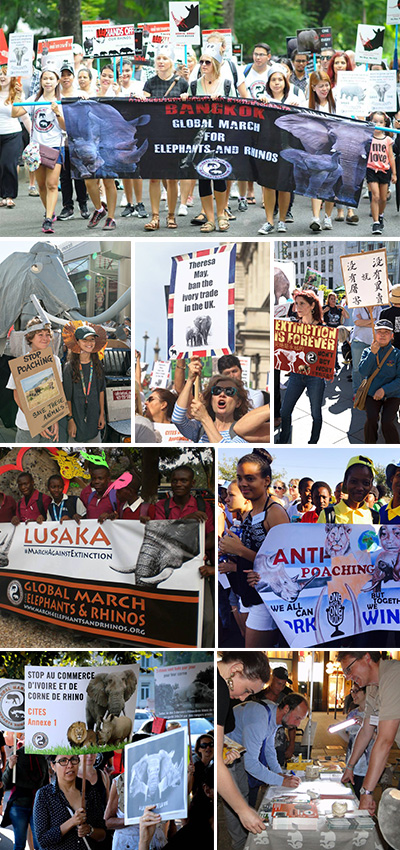
GMFER continued to make history, becoming the first grassroots-wildlife-advocacy organization to be credentialed to attend the 17th meeting of CITES (the Convention on International Trade in Endangered Species of Wild Fauna and Flora) in Johannesburg. On the opening day of the conference, thousands marched from the heart of the city to the entrance of the Sandton Convention Center where CoP17 was kicking off. The passionate and unprecedented event was organized by GMFER in partnership with collaborators from South Africa. During CoP17, between 24 September and 5 October 2016, GMFER and its membership from Africa and the world organized dynamic side events advocating for the rights of earth’s last iconic wildlife and pressing for Appendix1 for all African elephants. As of this writing, not all African elephants have Appendix1 status. GMFER will continue to press for Appendix1 for all African elephants until we achieve success.
GMFER plans to attend CITES’ CoP19 in Costa Rica in 2022; we plan to create some “good trouble” on behalf of mother earth and her children. Watch this space!
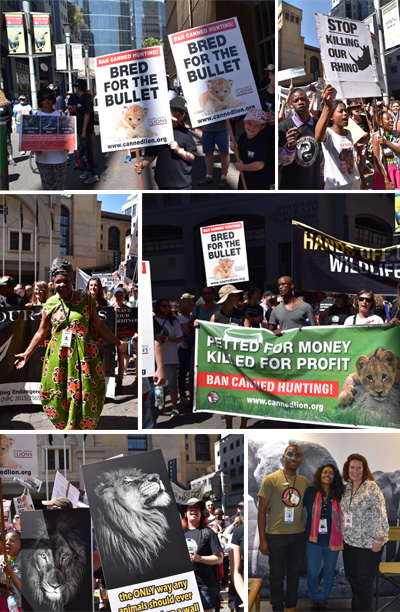
During these years and subsequent to CoP17, GMFER’s mission and vision were profoundly influenced by the overarching failure of conservation efforts throughout the African continent. Systemic corruption, ubiquitous wildlife markets, belief in lucrative unscientific myths, economic disenfranchisement, the absence of indigenous voices amplifying the fate of Africa’s wild heritage and a pervasive colonial ethos; all these factors are squarely at the center of the failure of conservation in Africa.
A plan to reimagine GMFER’s mission was set in motion, centering on a foundational vision to mitigate and reverse the causal factors influencing a global failure in conservation. GMFER’s global marches, protests and events continued through 2019: albeit, unlike GMFER’s original conversations about conservation, those that unpinned our first marches, our recent work has evolved to be categorically intersectional. Subsequent to CoP17, our efforts and philosophy have emphatically underlined the urgency and significance of amplifying indigenous voices speaking for wildlife. We follow similar principles by way of highlighting corruption, disrupting colonial modalities of conservation, banning the legal and illegal wildlife trade and dismantling unscientific myths driving extinction. A great deal of our time, resources and effort are focused on supporting events, programs and campaigns in Africa and Asia, specifically those led by coalitions of powerful indigenous voices.
CITES’ CoP18 was scheduled to take place in Colombo, Sri-Lanka during May-June 2019. GMFER’s President was born and grew up in Sri-Lanka, her association with the nation, and her love for Lanka’s last wild inhabitants lent the conference a noteworthy significance. Following substantial preparation in association with multiple groups on the ground, GMFER was forced to cancel its plans for CoP18 in Sri-Lanka due to the ‘Easter Bombings’ in Colombo; a series of coordinated Islamic terrorist attacks targeting churches and hotels in the nation’s capital in April 2019.
CoP18 was moved to Geneva in Switzerland and GMFER decided to forego attending given the logistical difficulties of rescheduling and the prohibitive nature of associated costs.

GMFER’s plans for 2020 and beyond: our marches, events, campaigns and programs will be informed by the following:
Wildlife and Social Justice advocates around the world including GMFER demand that all physical and online markets trading wildlife are permanently banned in light of the origin and spread of the coronavirus, covid-19. The pandemic is causing irreparable damage to lives and livelihoods around the world; it is also severely disrupting the global economy.
As of this writing, interested stakeholder are still investigating the COVID-19 origins story; initial analysis submitted that a bat was the likely reservoir host, and, while a pangolin has not been ruled out as the vector inducing “spillover”, the intermediate host or hosts remain undetermined in the absence of sufficient probabilistic accuracy. Whether the virus emerged at the Wuhan live animal market from an interaction between an animal and a human, or, whether it emerged at the Wuhan Institute of Virology via gain of function research, there is little doubt that aberrant anthropogenic disruptions to a previously intact human-wildlife interface triggered the onset of COVID-19.
Life has changed dramatically for global citizens in barely four months since the onset of covid-19 in China in December 2019. Given the staggering number of infected humans and the mounting death toll, any wildlife market continuing to operate anywhere in the world is tantamount to a ticking time bomb. The poaching, trafficking and farming of wild creatures and the use of wild animal body parts in commercial enterprises, whether legal or illegal must be banned. Education, subsidies and alternative sources of income must be explored and guaranteed for the disenfranchised, those traditionally dependent on trading wildlife for a living. Humans must work collectively and urgently to restore our wild world: a world that guarantees our existence and sustains civilization.
Cultural traditions that continue to exploit wild animals must move to revise such practices, legally enforcing plant-based technologies as alternatives. Alarmingly, the World Health Organization (WHO) has included TCM (Traditional Chinese Medicine) in its International Classification of Diseases, “a highly influential document that categorizes and assigns codes to medical conditions, and is used internationally to decide how doctors diagnose conditions and whether insurance companies will pay to treat them” (Nature, 2019).
TCM uses the body parts of a stunning variety of wild creatures, critically endangered and otherwise, in a plethora of “recipes”; rhino, leopard, pangolin, bat, tiger, lion, sea horse and even elephant make up a segment of a much longer list of “ingredients” purposed by TCM. Since the WHO’s inclusion of TCM in its ICD, poaching, trafficking and wildlife crime has increased. While causality cannot be substantiated, the trend is disturbing.
China’s appetite for TCM is actively pushing multiple species to the brink of extinction; additionally, the use of pathogen-heavy wild animals as “ingredients” sets the stage for the emergence of future zoonoses. The WHO endorsed TCM without rigorous and lengthy clinical trials, without double blind studies and with little scientific evidence to defend its decision. The WHO’s association with unfounded and potentially dangerous “treatments” is reprehensible.
Taxpayers around the world, whose largesse ensures the viability of the WHO expect an organization that operates with integrity. The WHO has been bestowed the privilege of overseeing and protecting the world’s health, it must do better; governments must ensure it does.
The WHO and China are also culpable of withholding vital information surrounding the onset and spread of covid-19. The current and future welfare of our species depends on the transparent sharing of information and data; politicizing the pandemic is unacceptable; mitigating the devastation caused by covid-19 and any future pathogen will require steadfast collaboration and co-operation among all nations, including the USA.
Covid-19 has demonstrated that humans cannot continue living and behaving as we did before. The wild world demands our respect and demands restoration; the consequences of not doing so are not only unethical but are verifiably dangerous. It is ironic that our disregard of earth’s wild children has unleashed a pathogen that has no regard for human health, human safety and the global economy.
Reverence is not merely a word; it is survival in action.
We demand the following:
That all wild animal markets are permanently banned, globally.
That TCM (Traditional Chinese Medicine) be removed from the WHO’s diagnostic compendium, until and unless all animal body parts (wild or otherwise) are removed from TCM’s ingredients. And, until and unless TCM is subject to rigorous clinical trials, double blind testing and is supported via consensus by the wider scientific community.
That the use of animal body parts in TCM be universally condemned, specifically by those nations who are active participants in China’s Belt and Road Initiative (BRI); an initiative that actively promotes TCM with no qualification.
That governments take immediate action to regulate and monitor any TCM products imported into their nations.
That governments take immediate action to sanction China via trade agreements in the context of China’s continued use of animal body parts in TCM, a dangerous practice that drives extinction and sets the stage for pathogens and spillovers.
That international corporations with production operations in China, move production elsewhere unless China modifies its laws and policies regulating the use of animal body parts in TCM. Specially, China must remove the use of all animal body parts from its pharmacopoeia governing TCM.
That subsidies and alternative sources of income are explored and guaranteed for the disenfranchised, those traditionally relying on wildlife markets for a living.
That the WHO, China, the USA and all nations ensure the expedient and transparent sharing of covid-19 related information and data between key stakeholders to guarantee the recovery of a now fragmented global economy.
That governments take immediate action to restore wild places and safeguard the lives of wild creatures; that an intact and healthy human-wildlife interfaces be a priority of world governments post covid-19.

The years 2022 and 2023 were significant for GMFER. Our vision to build thriving human and animal communities came into sharper focus. We nurtured our relationships on the ground, amplified indigenous voices passionate about wildlife and committed to organizing our signature global events to be concurrent with CITES’ CoPs.GMFER strategized for, organized and implemented two noteworthy events between 2022 and 2023. The first was GMFER’s engagement in CITES’ CoP19 in Panama. The second was Beating Plastic Pollution at the Ngwerere tributary in collaboration with Mizu Eco-Care.
Cop19 CITES
GMFER, PWCC and our partners represented the many thousands of global voices standing for wildlife at CITES’ CoP19 in Panama City, Panama, in November 2022.
GMFER attended CITES’ CoP19 in Panama in 2022. Collaborating with PWCC (The Panama Wildlife Conservation Charity), GMFER made good trouble on the opening day of CITES in Panama. We staged a Celebration of Wildlife outside the Panama Convention Center. ~200 children, young adults and teachers from surrounding Panamanian Schools joined GMFER, PWCC, our partners and others to celebrate earth’s wild wonder. Under the banner of “Nature not Money”, these young voices called on Management Authorities to place nature over money, to vote for a living earth. In future collaborations, GMFER hopes to work with the PWCC to establish Appendix 1 for Oophaga vicentei, a poison frog facing significant threats throughout Panama. In turn, PWCC will network with the EU, lobbying on behalf of Appendix1 for all African elephants.
Significantly, prior to the moratorium imposed on the live capture and trade of all African elephants, Nkateko Mzimba, a Transfrontier Africa and GMFER representative presented an intervention, addressing the plenary session debating the live capture and trade of African Elephants in the context of Agenda Item 66.4. We thank Iris Ho from the Pan African Sanctuary Alliance for supporting the intervention.
And there’s a lot more! You can read about it here.
Inaugural Ngwerere Cleanup, World Environment Day, Monday, June 5, 2023
Originating in the capital city of Lusaka, the Ngwerere is one of two tributaries of the Chongwe River. Water from the Ngwerere underpins local economies and ecologies, making the stream socially and environmentally significant. The Ngwerere feeds the Chongwe, the Chongwe river drains into the mighty Zambezi which meets the vast slate of the Indian Ocean in Mozambique.
The Ngwerere has experienced plastic pollution for over a decade. Mounds of garbage inhibit the tributary’s waters from reaching the Chongwe dam; the water itself is undrinkable. In response to the extent of contamination, GMFER and Mizu Eco-care envisioned and organized a collaborative project to clean-up the Ngwerere. The pilot event for the project took place on World Environment Day, June 5, 2023.
The pilot was a joint effort engaging many enthusiastic volunteers, college students, the Chongwe Municipal Council, the Lusaka City Council, and the Honorable Collins Nzovu, Zambian Minister for Green Economy and the Environment.
The clean-up effort on World Environment Day was an enormous success.
Mizu Eco-Care and GMFER will strategize, organize and install successive clean-ups of the Ngwerere as funds become available. Our hope is to maintain the Ngwerere in as debris-free a state as possible, and, to eradicate plastic pollution along the tributary’s path as it meanders to meet the Chongwe river.
Plans are in progress to broaden the scope of the project, extending the initiative to Beat Plastic Pollution in other tributaries and rivers of Zambia. The effort will demand substantial funding; grant proposals are currently being developed.
You can help us here donate.
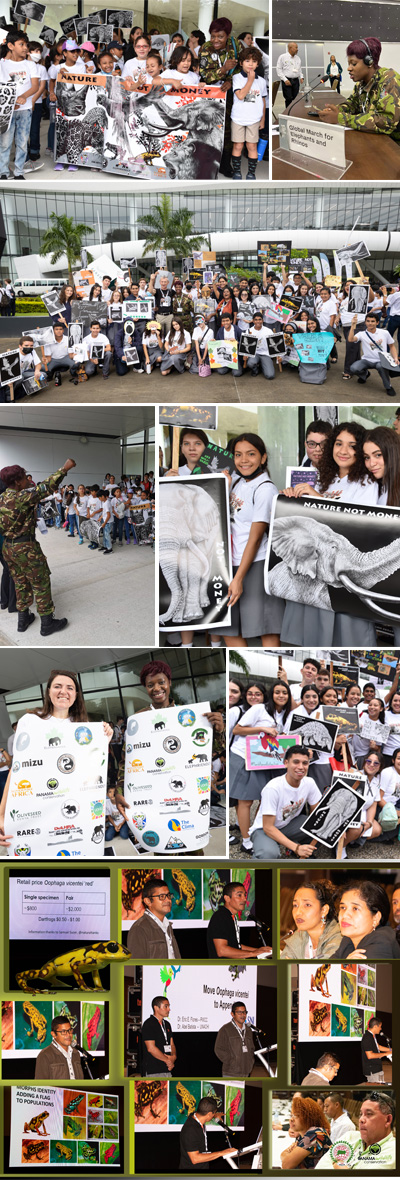

Stay in the know.
Be ready to act.
To keep up to date with our latest news, events, marches,
campaigns and fundraising activities.

